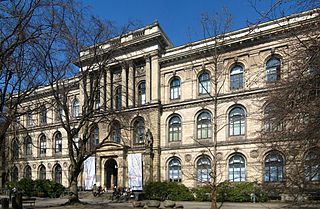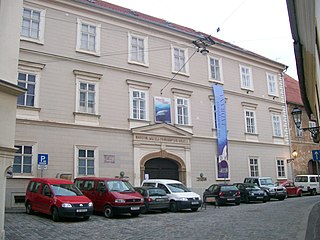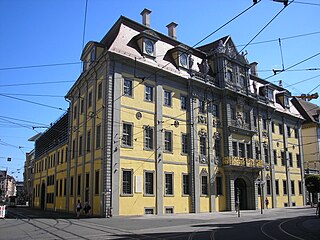
Entomology is the scientific study of insects, a branch of zoology. In the past the term "insect" was less specific, and historically the definition of entomology would also include the study of animals in other arthropod groups, such as arachnids, myriapods, and crustaceans. This wider meaning may still be encountered in informal use.

The Natural History Museum in London is a natural history museum that exhibits a vast range of specimens from various segments of natural history. It is one of three major museums on Exhibition Road in South Kensington, the others being the Science Museum and the Victoria and Albert Museum. The Natural History Museum's main frontage, however, is on Cromwell Road.

The Field Museum of Natural History (FMNH), also known as The Field Museum, is a natural history museum in Chicago, Illinois, and is one of the largest such museums in the world. The museum is a popular natural-history museum for the size and quality of its educational and scientific programs, as well as due to its extensive scientific-specimen and artifact collections. The permanent exhibitions, which attract up to two million visitors annually, include fossils, current cultures from around the world, and interactive programming demonstrating today's urgent conservation needs. The museum is named in honor of its first major benefactor, the department-store magnate Marshall Field. The museum and its collections originated from the 1893 World’s Columbian Exposition and the artifacts displayed at the fair.

The Natural History Museum is a natural history museum located in Berlin, Germany. It exhibits a vast range of specimens from various segments of natural history and in such domain it is one of three major museums in Germany alongside Naturmuseum Senckenberg in Frankfurt and Museum Koenig in Bonn.

The Natural History Museum Vienna is a large natural history museum located in Vienna, Austria. It is one of the most important natural history museums worldwide.

Francis Walker was an English entomologist. He was born in Southgate, London, on 31 July 1809 and died at Wanstead, England on 5 October 1874. He was one of the most prolific authors in entomology, and stirred controversy during his later life as his publications resulted in a huge number of junior synonyms.

The History of Science Museum in Broad Street, Oxford, England, holds a leading collection of scientific instruments from Middle Ages to the 19th century. The museum building is also known as the Old Ashmolean Building to distinguish it from the newer Ashmolean Museum building completed in 1894. The museum was built in 1683, and it is the world's oldest surviving purpose-built museum.

The National Museum (NM) is a Czech museum institution intended to systematically establish, prepare, and publicly exhibit natural scientific and historical collections. It was founded in 1818 by Kašpar Maria Šternberg. Historian František Palacký was also strongly involved in the foundation of the museum.

Museo Galileo, the former Istituto e Museo di Storia della Scienza is located in Florence, Italy, in Piazza dei Giudici, along the River Arno and close to the Uffizi Gallery. The museum, dedicated to astronomer and scientist Galileo Galilei, is housed in Palazzo Castellani, an 11th-century building which was then known as the Castello d’Altafronte.

The Goulandris Museum of Natural History is a museum in Kifisia, a northeastern suburb of Athens, Greece. It was founded by Angelos Goulandris and Niki Goulandris in 1965 in order to promote interest in the natural sciences, to raise the awareness of the public, in general, and in particular to call its attention to the need to protect Greece's natural wildlife habitats and species in the danger of extinction.

The Museum Wiesbaden is a two-branch museum of art and natural history in the Hessian capital of Wiesbaden, Germany. It is one of the three Hessian State museums, in addition to the museums in Kassel and Darmstadt.

The Palaeontological Museum in Germany, is a German national natural history museum located in the city of Munich, Bavaria. It is associated with the Ludwig-Maximilians-Universität. It has a large collection of fossils of animals and plants such as Mesozoic reptiles, early elephants and saber-toothed cats. The paleontological and geological institute which houses the museum is formally called the Bavarian State Collection for Palaeontology and Geology, which itself is one of several institutions which make up the Bavarian Natural History Collections.

The Hungarian Natural History Museum in Budapest, dating back to 1802, houses the largest natural history collections of Hungary and the region.

The NTNU University Museum in Trondheim is one of seven Norwegian university museums with natural and cultural history collections and exhibits. The museum has research and administrative responsibility over archaeology and biology in Central Norway. Additionally, the museum operates comprehensive community outreach programs and has exhibits in wooden buildings in Kalvskinnet.

The Museum of Natural History in Görlitz, Germany is a natural history museum with focus on zoology, botany and geology. Since 2009, the museum has been part of the Senckenberg Gesellschaft für Naturforschung with headquarters in Frankfurt/Main. The main field of research is soil biology. In the years 2006 to 2017 the number of visitors was between 25,000 and 34,000, in the year of the 3rd Saxon State Exhibition 2011 it was even 47,000.

The State Museum of Natural History Stuttgart, abbreviated SMNS, is one of the two state of Baden-Württemberg's natural history museums. Together with the State Museum of Natural History Karlsruhe it is one of the most important repositories for state-owned natural history collections.

The State Natural History Museum in Braunschweig, Germany, is a zoology museum. It was founded in 1754.

The Estonian Museum of Natural History is the Estonian national museum for natural history. It is situated in Tallinn's Old Town.

The Croatian Natural History Museum is the oldest and biggest natural history museum and the main body for natural history research, preservation and collection in Croatia. Located on Dimitrije Demeter Street in Gornji Grad, one of the oldest neighbourhoods of the Croatian capital Zagreb, it owns one of the biggest museum collections in Croatia, with over 2 million artefacts, including over 1.1 million animal specimens. It was founded in 1846 as the "National Museum". The National Museum was later split up into five museums, three of which were in 1986 merged as departments of the newly named Croatian Natural History Museum. The museum contains a large scientific library open to the public, and publishes the first Croatian natural history scientific journal, Natura Croatica.

The Angermuseum, Erfurt's first municipal museum, was officially opened on 27 June 1886. It is housed in a building that used to house Erfurt's public weighing scales, where travelling mechants would bring their wares to be weighed for payment of the city's customs duties. The museum faces Anger square; Anger meaning a town common. Originally, only the gallery on the first floor was used for the museum.





















